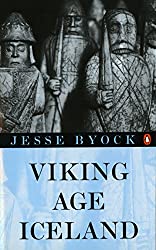
Rating: 7.4/10.
Book about the history and societal structure of medieval Iceland, particularly the period from the earliest settlement by people from Norway (~870AD) until about 1200AD. All of the arable land was quickly settled within about 60 years of the island’s first settlement, leading to lots of disputes and feuding over the land; details of these disputes are described in the Icelandic sagas. Iceland was also very isolated both geographically and economically: they produced little that was considered valuable in the outside world, everybody lived in small, self-sufficient farms, and there were no urban settlements. Wood was scarce so the houses were made of turf; subsistence consisted of fishing, herding, and gathering of wild plants. The unpredictable weather and occasional volcanic eruptions led to frequent famines.
Viking age Iceland was a mostly egalitarian society, without any central authority that controlled the entire island or collected taxes. People were divided into two classes: the gothi (chieftains) and bondi (farmers). The gothi had a privileged position in the legal system since a bondi was required to have a gothi as advocate to participate, so the gothi charged fees (paid in land or livestock) for this service. However, the gothi only had limited control of his constituents (who were free to choose their gothi), and his actual power depended on how many people he could get to ally with him. Disputes were handled through a combination of lawsuits and violence: despite the sophisticated legal system, greedy gothi who try to obtain wealth through legal trickery often found themselves killed in revenge. At the same time, people could not afford to carry out violent disputes for a long time, so more often than not, they resolved issues through compromise. After a judgment, the legal system had few resources to carry out punishment: the strongest sentence was to be outlawed, where person can be killed by anyone with no punishment, but the winner is still left with the task himself.
The author draws evidence mostly from the Icelandic sagas, which to some historians have questionable historical value because of the difficulty of distinguishing fact from fiction in these sagas, which are frequently embellished. However, these sagas are written to be believable, meaning that even if the facts can’t be trusted, they still shed light about social norms and expectations. Occasionally, the author also uses archaeological evidence, but this type of evidence is scarcer. The bulk of this book consists of a synopsis of the story from a saga, followed by a discussion of inferences that can be drawn about the social and legal system through the story. Most of the book is about disputes between people and ways that they are resolved, as the sagas largely revolve around complex disputes. The Icelandic Free State period gradually ended in the 13th century, as Christianity grew in influence, power became more and more consolidated among fewer numbers of chieftains, and the king of Norway gained control over the island.
Overall, this book contains a lot of well researched information about medieval Iceland, however the writing is quite dry and difficult to get through, so I ended up skimming after a while. There are many details about intricacies of medieval laws and relationships between characters in the sagas, that gets repetitive after a while. Also, some topics are missing completely from this book, such as the exploration of Greenland and North America, and all the literary and non-historical Icelandic sagas.



